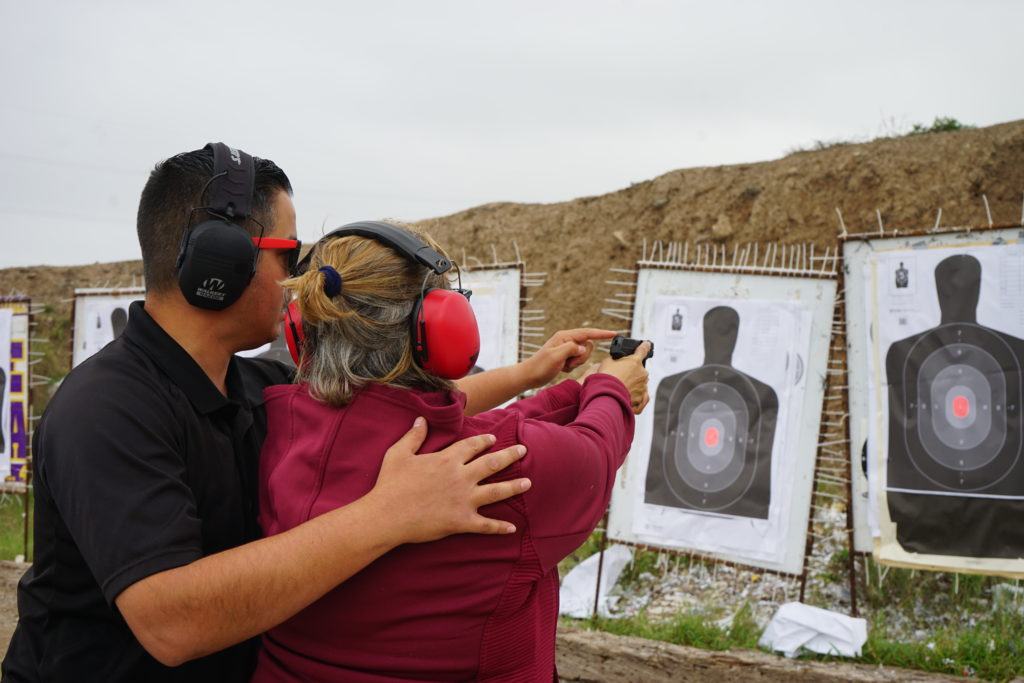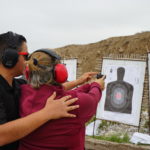“If I Never Had to Worry About Being Shot, I Would Never Carry”
On a crisp Sunday afternoon in Royse City, Texas, 32-year-old Cesar Hurtado unzips a hard shell case to reveal a custom-built AR-15-style rifle in his living room. Emblazoned on the side of the gun is the tagline “no war, no gods, no masters.” Hurtado’s interest in firearms started with hunting, but after the 2019 El Paso shooting that targeted Latinos, Hurtado knew he had to embrace firearms for his own protection. Today, the Colombian-American is a member of the burgeoning Latino Rifle Association (LRA), a self-described progressive organization that sprouted up online during the pandemic to provide self-defense and firearms education to Latinos. Many of the approximately 850 members are worried about the rise of far-right white extremism, while others are looking to connect with gun owners sharing their progressive ideals or Latino identity.
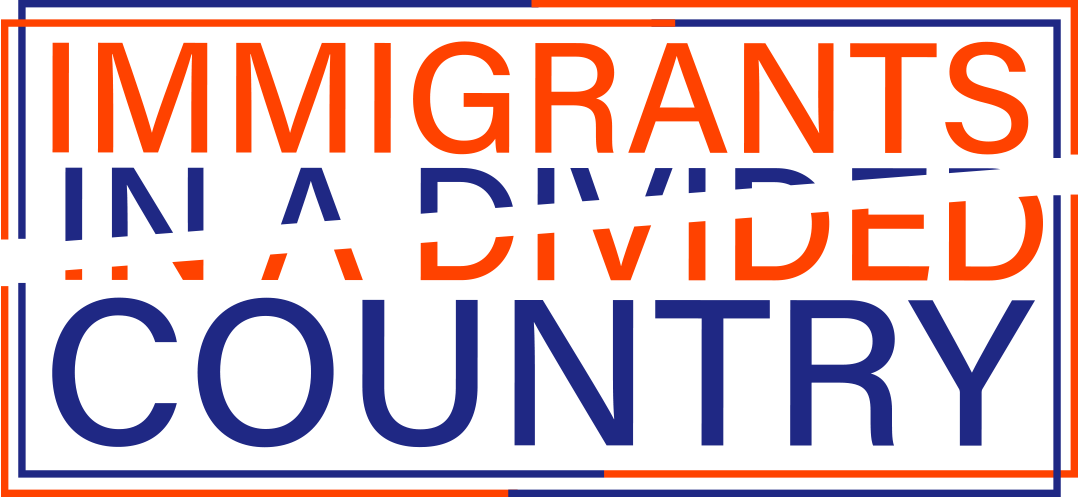 “For white gun owners, they feel they have a right to a gun,” Hurtado said, “but for Latino gun owners, it’s a matter of survival and safety.” Across the United States, one fifth of new gun owners are Hispanic. Some are young, politically engaged, and searching for a way to protect themselves amid an uptick in attacks on Latinos and an unprecedented wave of mass shootings. In Texas, home to the nation’s second-highest number of school shootings, some Latino teachers are embracing firearms training to protect schoolchildren and themselves.
“For white gun owners, they feel they have a right to a gun,” Hurtado said, “but for Latino gun owners, it’s a matter of survival and safety.” Across the United States, one fifth of new gun owners are Hispanic. Some are young, politically engaged, and searching for a way to protect themselves amid an uptick in attacks on Latinos and an unprecedented wave of mass shootings. In Texas, home to the nation’s second-highest number of school shootings, some Latino teachers are embracing firearms training to protect schoolchildren and themselves.
A version of this story was published by The Guardian as part of their Guns and Lies series, and by palabra.by NAHJ.
Latinos face gun violence, hate crimes, and far-right extremist attacks at an alarming rate. This has galvanized some to seek out self-defense in weapons, while others advocate for greater gun control measures. But even as they take advantage of their Second Amendment rights, some remain ambivalent about guns. They often grapple with the risks and responsibilities they take on when they turn to firearms for protection, and the way their choices are perceived by law enforcement, family members, and the communities where they live and work.
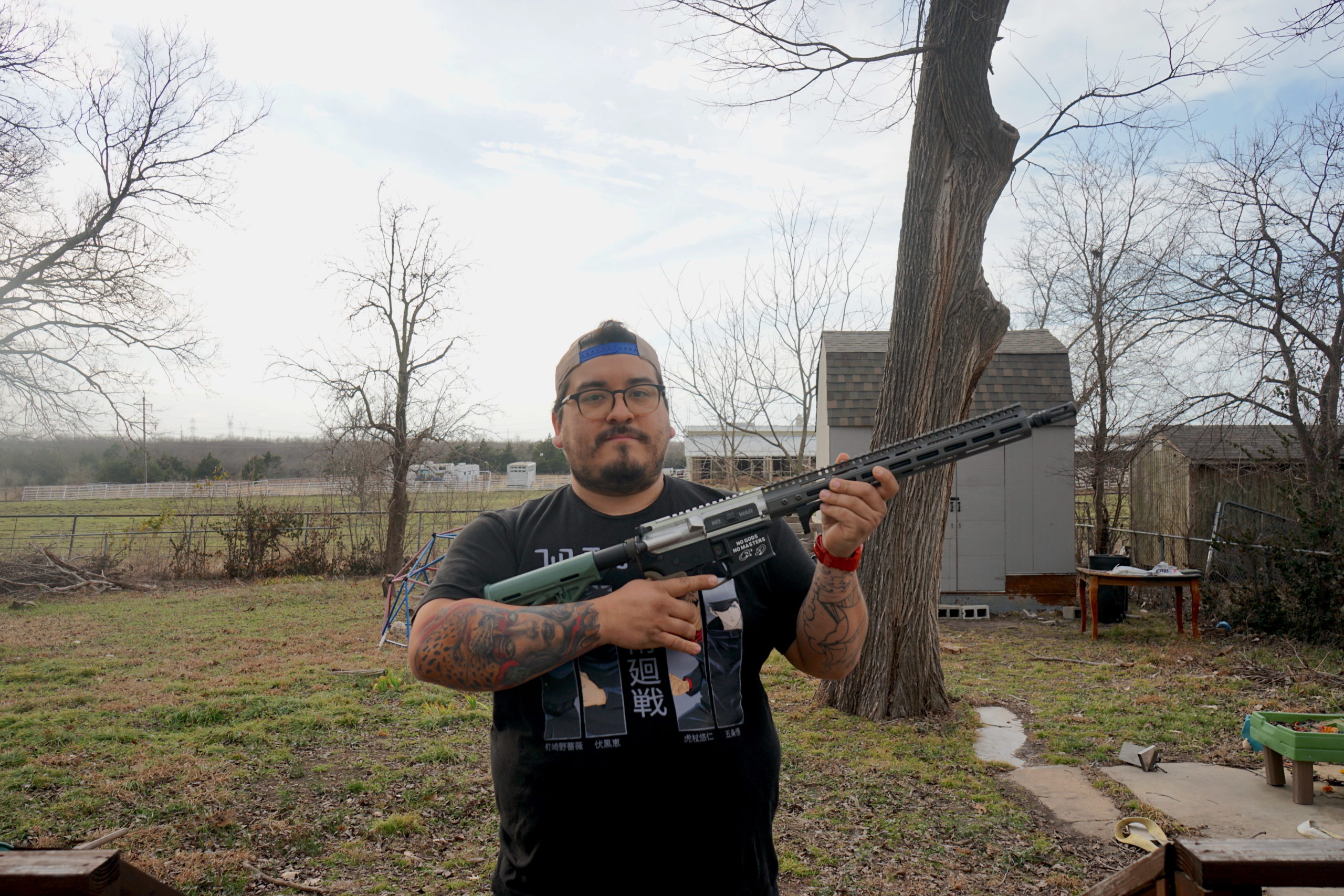
Cesar Hurtado holding his custom built rifle in Royse City, Texas. Photo credit: Sabrina Toppa
Hurtado’s parents lived through the period of La Violencia in Colombia, a years-long political conflict that saw the deaths of an estimated 300,000 civilians. As a result, his mother and sister have a deep aversion to guns, and he has never told his family that he owns a gun, let alone that he built his own custom rifle. Hurtado said he understands his mother’s opposition to guns, but he believes having a gun is necessary in these times of heightened xenophobia. As a first-time gun owner, he has had to conceal his interest in firearms from his family while also navigating a Texas gun culture that is not necessarily inclusive of people of color.
Subscribe to our newsletter to stay up to date on Feet in 2 Worlds’s coverage of immigrant communities and the work of new and veteran immigrant and BIPOC reporters.
Although gun ownership is woven into the state’s founding myths of gun-slinging vaqueros and cowboys, Texas was once at the forefront of gun safety laws. In 1870, it became one of the first states in the nation to ban firearms outside the home. It prohibited automatic weapons and levied a 50% tax on guns in the 1920s, and then was one of the first to fully ban machine guns in 1933—a full year before the federal government began regulating them. Today, however, Texas is almost synonymous with loose gun laws and the state has some of the highest gun sales in the country.
Last year, Texas became one of the few states nationwide to pass an open carry law without requiring a license, but Hurtado said his identity as a Latino man impacts his ability to comfortably do so. “They might see us as a threat,” Hurtado said. “For the longest [time], I made a point not to get a handgun, because if I were to get pulled over, I didn’t want to be just a brown guy with a gun.”
“What If I’m Next?”
Between 2019 and 2020 gun purchases by Latinos grew nearly 50%, according to the firearms trade association, the National Shooting Sports Foundation. Multiple factors drove the spike: rising crime rates, greater gun violence, mass shootings, anti-immigrant sentiment against Latinos, and far-right extremism. Texas was the site of three of America’s ten deadliest mass shootings, which have taken place in areas with significant Latino populations. Last year, the state saw a 61% uptick in white supremacist propaganda, fanning fears that far-right extremism was growing at an accelerated pace in America’s second-largest state. As one of the most targeted groups for hate crimes in the U.S., it’s no surprise that increasingly Latinos are turning to guns as a self-defense tool.
“The perfect storm of the pandemic, racial justice uprisings, and intensely divisive politics pushed people toward gun ownership who were previously on the fence about it,” said Dr. Angela Stroud, a sociologist at Northland College who studies gun culture. Historically, Hispanics, Blacks, and women were the groups least likely to own guns, she said, but now gun ownership has begun to better reflect the U.S. population.
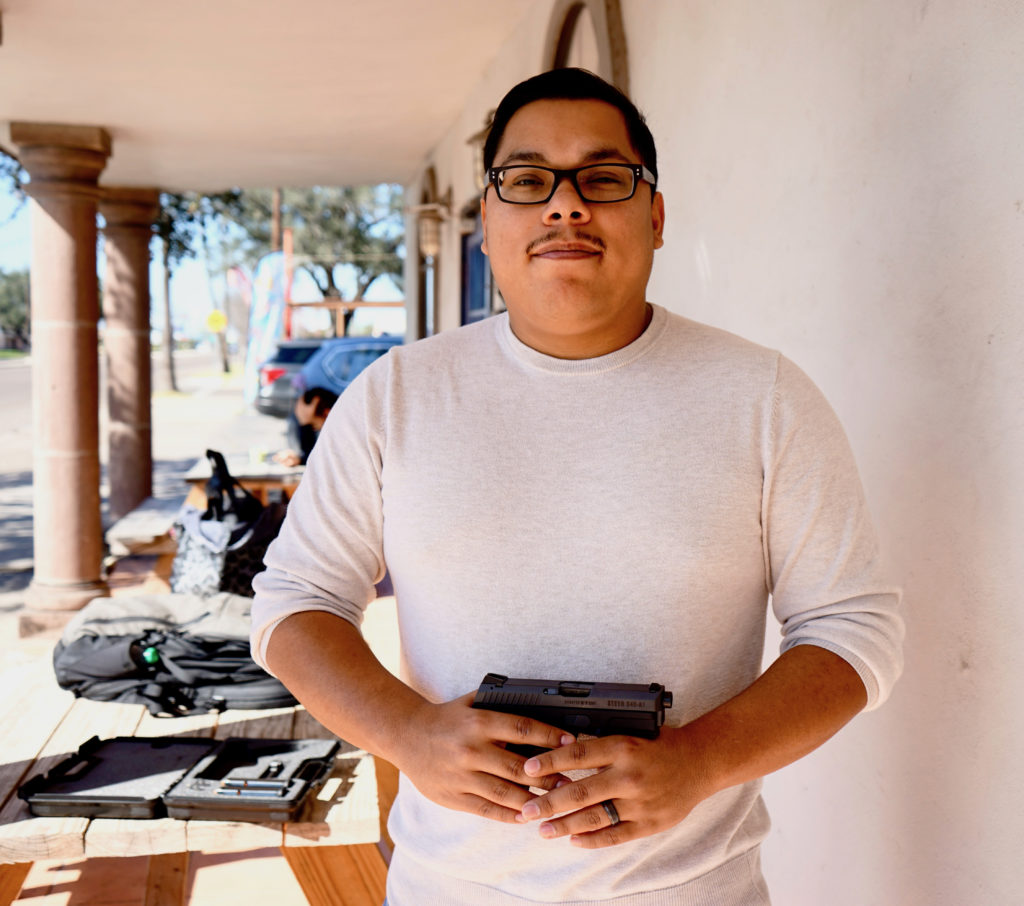
Isaiah Salas, member of the Latino Rifle Association, based in the Rio Grande Valley, in Texas. Photo credit: Sabrina Toppa.
“Most people wouldn’t bother with firearms if they didn’t think it was necessary—if they didn’t think there were legitimate threats against them,” Hurtado said. “If I never had to worry about being shot, I would never carry.”
Texas has a long history of anti-Latino sentiment. Organized campaigns of violence against Latinos, like La Matanza (The Massacre) and La Hora de Sangre (The Hour of Blood), resulted in the lynching of Latinos in Texas during the 19th and 20th centuries. While exact numbers are impossible to confirm, historians estimate hundreds, or even thousands, of Latinos were killed. Latinos not only faced death by gunshot in targeted campaigns, but in the mid-1800s, the capital city of Austin even expelled Mexicans who lacked a white person to vouch for them.
In one of the worst massacres of Latinos in U.S. history, 15 Latino villagers in the Rio Grande Valley were shot at gunpoint for their alleged link to the Mexican revolution in 1918. More recently, in the Rio Grande Valley, LRA members like Isaiah Salas, 27, are beginning to connect this violent history to the current trends of anti-immigrant rhetoric and far-right extremism.
“It really gets you scared, because it’s like, what if I’m next?,” asked Salas.
“Don’t Bring That Into My House”
Across America, however, there’s no uniform way that Latinos in the U.S. view guns. According to a 2022 Pew Research Center survey, 81% of Latino immigrants believe restricting gun ownership is more important than protecting gun rights. But for Latinos born in the U.S., the figure drops to 65%. The highest support for gun control comes from Latinos who speak Spanish as their primary language—not English-speaking Latinos, suggesting that recent immigrants have not embraced American ideas about gun ownership.
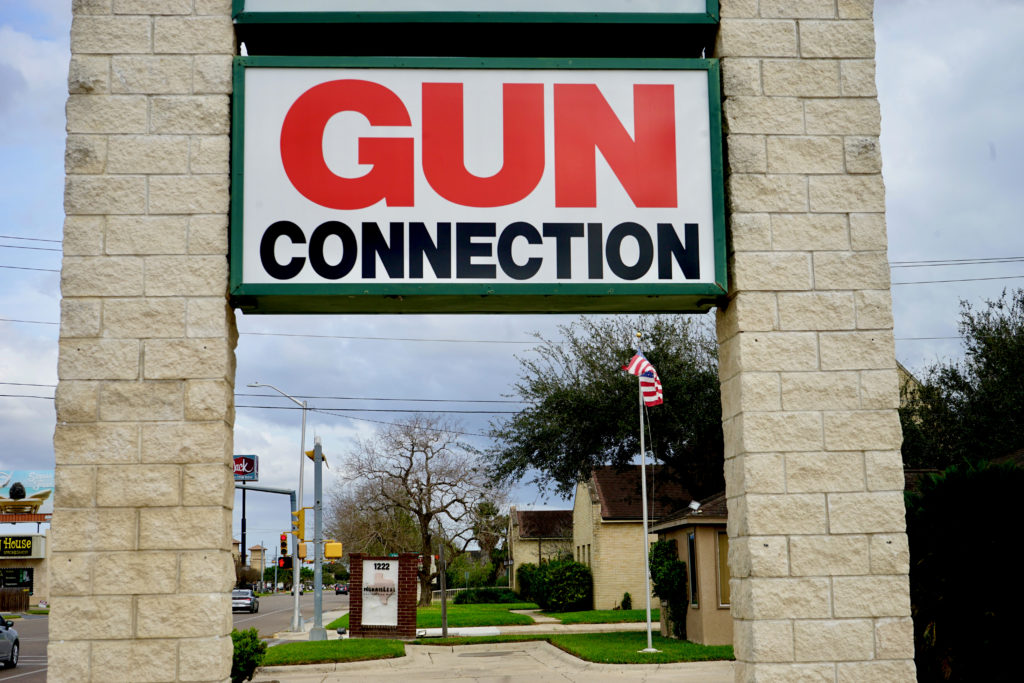
Gun sign in Texas. Photo credit: Sabrina Toppa.
Even in Texas, not all Latinos are in favor of firearms. Texas Democratic congresswoman Sylvia García, who represents a majority-Hispanic district that includes South Houston, has condemned guns and called for greater gun control through legislation. Her district is home to nearly 40% of all gun violence deaths in the state. “Gun violence must end now across Latino communities and all communities,” she told Fi2W. “We must enact change now to protect our vecinos [neighbors].”
For others like Paul Perez, a Mexican-American living on the U.S.-Mexico border, the decision to buy a firearm was “bittersweet,” because he never wanted a gun. The 35-year-old’s job in health insurance regularly took him on languorous drives through swaths of Texas he saw as unsafe because of gang activity and narcotics smuggling. His work also put him in contact with strangers, galvanizing him to carry a gun in a lockbox in his car. To this day, his grandmother does not understand why he stores firearms in a gun cabinet bolted to the floor of her home. He’s unable to talk about guns with her, he says, because of generational differences and her being “stuck” in her own beliefs. She is in her 70s and was born in Mexico, where the process for acquiring a gun is more difficult and the culture is less open toward guns, he says.
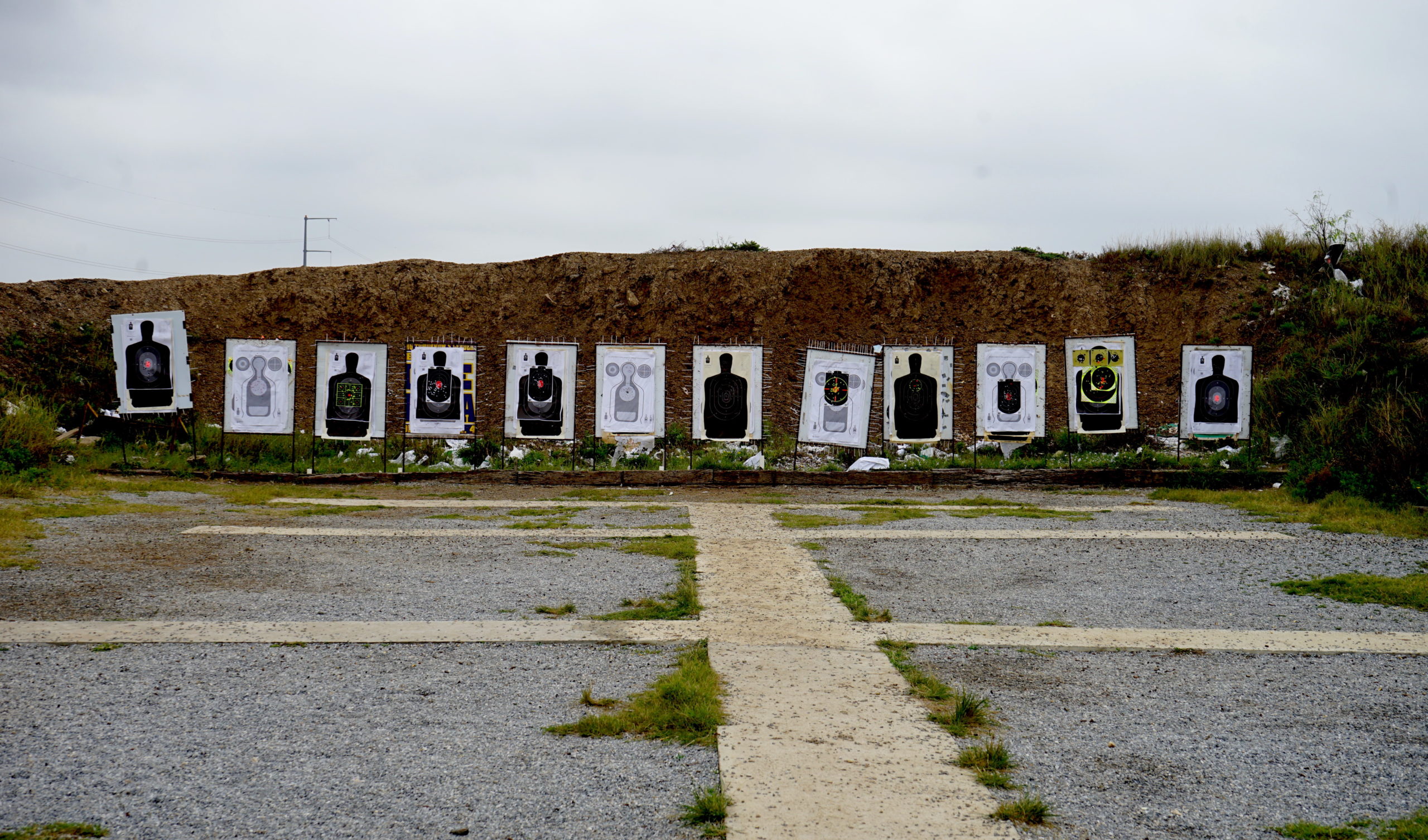
Gun range in Los Fresnos Texas. Photo credit: Sabrina Toppa.
Beyond these family differences, Perez is also unsure how law enforcement perceives him as a Latino man wielding a firearm. On average, 200 Latinos in the U.S. are killed by police each year, with Latinos facing a higher likelihood than white people of being killed during police encounters. “I’ve never wanted to believe that there’s racial profiling,” Perez says. “But I do see it here and there – even the people of my own race do it to each other.” Whenever he gets pulled over, he always tries to announce his gun in front of the police officer to avoid conflict, and points out that respect is a cardinal component of gun ownership. “You’re looking out for their safety. Most of the time, they’re like, ‘Hey, man, just be careful. Thanks for a heads up,’ and they just let me go,” he says.
Although the fear of far-right extremism motivates some Latinos to seek out guns, some also point out that simply carrying a gun can lead to unfavorable interactions with the police, who might erroneously read criminal intent into their motivations for having a gun. According to the ACLU of Texas, Latinos in the Rio Grande Valley are already more likely to be fearful of interactions with police because of the heightened presence of border agents. They not only face a higher number of traffic stops, but also run the risk of being stopped on dubious grounds like their ethnicity. The LRA, which started about a month before the George Floyd protests in 2020, is aware of police profiling of their communities, and bans members employed in law enforcement—a clear difference between the LRA and the National Rifle Association, which valorizes law enforcement’s use of guns to protect citizens. Although ostensibly sharing a common goal of gun education, the LRA and NRA could not be more different, some members say. The LRA takes on a progressive mantle, with many members identifying with the political left and claiming that the National Rifle Association would not accommodate their progressive views.
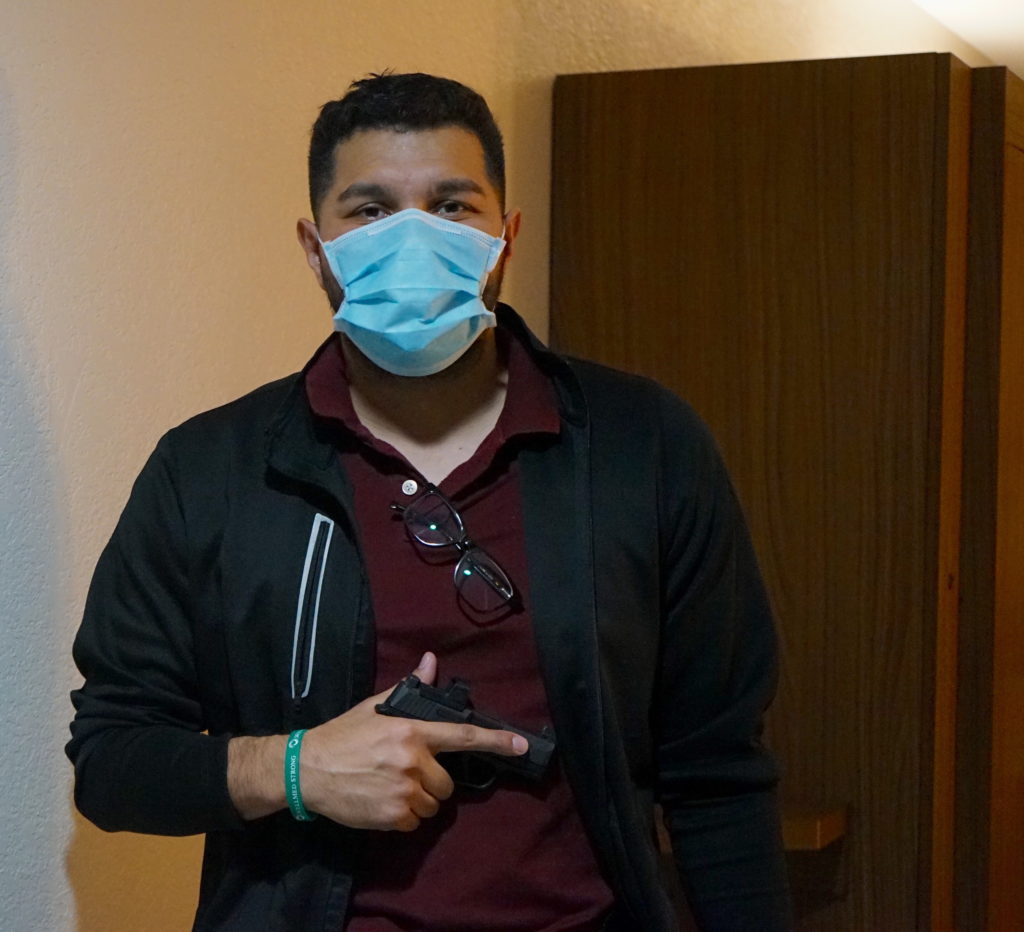
Paul Perez holding his gun in the Rio Grande Valley, Texas. Photo credit: Sabrina Toppa.
For Paul Perez, gun ownership is laden with anxiety. He belongs to neither the NRA nor the LRA. Though he generally aligns with the Republican party, viewing gun education as vital to his safety, he still worries about the day he might be called to use one. It’s not an uncommon fear. Recently, Perez visited a gun range with a friend who was vacillating on purchasing a firearm. After his friend fired one shot, the friend found himself in a fit of panic. Perez tried to coach him through his anxiety. “What are your concerns? What do you feel?” His friend said the idea of using a gun against someone unnerved him.
Perez told him he understood. Although he owns guns for safety, Perez says he does not necessarily feel safer as a gun owner. Any time his friends post a picture of a new gun on Snapchat, giddily labeling it as a “new toy,” Perez reprimands them. “It’s not a toy….That’s the worst way to look at it.”
Accessing guns has been a privilege and a responsibility for Perez, but one weighted with grave risks. He is aware that a police officer might misconstrue his gun as a threat, or that another gunman might target him simply because he is carrying a gun too. For him, it is part of a careful calculation. “The world [we] live in, it is scary,” he says. A gun at least makes him feel that he can control a situation that is often unpredictable, unscheduled, and unfair. “I guess you can say I’m officially a Texan,” he says about gun ownership. “But it is a lot of responsibility.”
“Firearms Aren’t Toys—These Are Dangerous Tools”
Despite its name, the Latino Rifle Association opens its doors to gun enthusiasts regardless of their race, and claims no affiliation with the National Rifle Association. The group exists predominantly online, but to ensure the safety of members, the LRA encourages local chapters to initially meet without guns. “Firearms aren’t toys—these are dangerous tools,” says Salas, who is in the process of starting his own LRA chapter in the Rio Grande Valley. “I’m not dumb; I understand they’re designed to destroy things… so this is something we have to take seriously.”
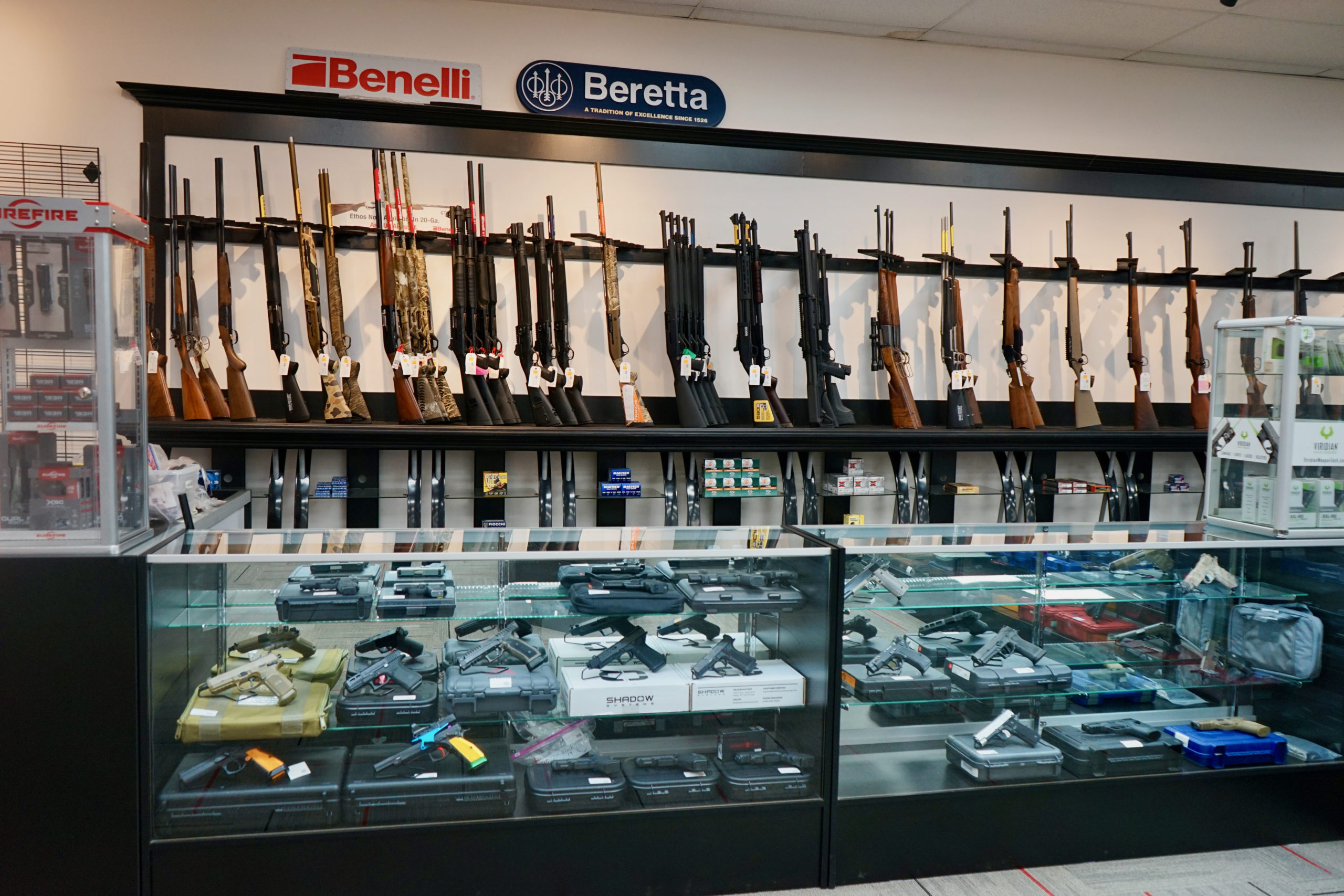
Guns on display at a Texas gun shop. Photo credit: Sabrina Toppa.
Salas, a fourth-generation Mexican-American living in a border city, says his family largely supports his gun rights advocacy, except for his mom (almost 80% of Latinas want to restrict guns). “It’s hard for her to detach firearms from anything related to gangs, crime, or bad news,” Salas says. Growing up in areas where gangs were prevalent, she forbade him from playing with toy guns as a child. When Salas bought his first gun as an adult, she told him, “Don’t bring that into my house… Not even the car, nothing—leave it at home.” Still, she has never stopped him from taking his younger siblings to a gun range to learn about firearms, and she understands his pull toward the LRA. “She’ll never be on board, but she understands what this organization means to me,” he says.
Salas says starting an LRA chapter in the Rio Grande Valley would allow him to do his part in uprooting the toxic masculinity in American gun culture. He says Latina trans women on the border have been among the first to join—their interest in the group has largely been spurred by the rise of anti-trans violence in the state. In recent years, Texas has had one of the highest murder rates of transgender people in the nation, coupled with some of America’s most restrictive and punitive anti-trans laws. “A lot of them will say they don’t know about firearms, they’re not that knowledgeable about firearms, but they want to learn,” Salas said.
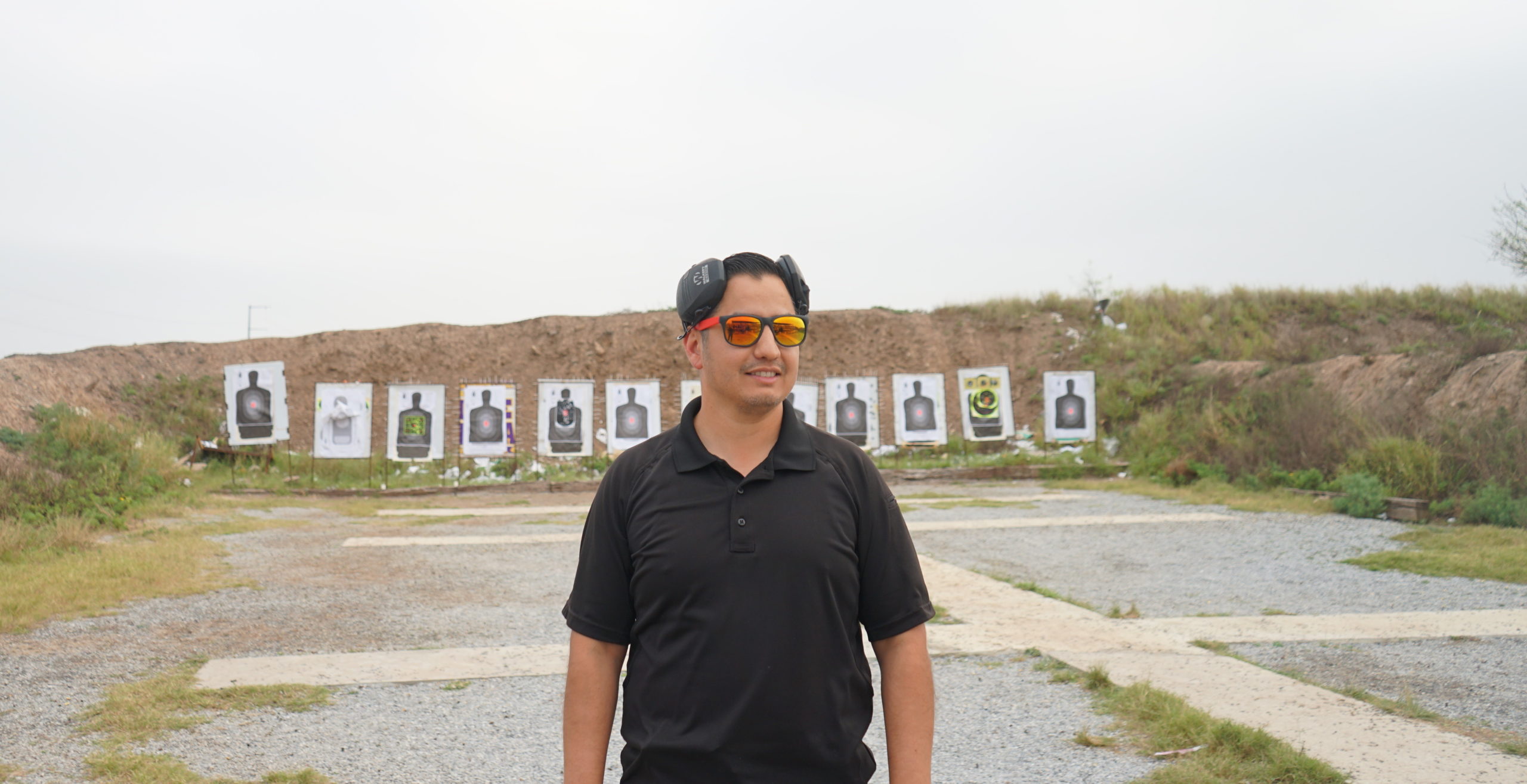
Law enforcement officer Julian Longoria offers gun safety lessons in Los Fresnos, Texas. Photo credit: Sabrina Toppa.
Salas’ own understanding of what gun ownership means has evolved in reaction to both the machismo within Latino culture and a “hyper-masculine and toxic” white gun culture that he says is embodied by groups like the NRA. He’s critical of Latino men who pick up a gun just to demonstrate their virility, but also the NRA’s culture of fear. He hopes the LRA can provide an avenue for Latinos who identify with neither group to reshape what gun ownership means, stripping it of its conservative cast. For him, the LRA is a way to engage in social advocacy, particularly in colonias along the Texas-Mexico border. Although Salas knows residents in one of Texas’ most underprivileged areas are not necessarily discussing gun rights, he thinks community-building and engagement might be a way to change inaccurate perceptions of gun owners as aggressive, violent or uncaring about their neighbors.
He also hopes the LRA will dispel myths about gun laws in the Rio Grande Valley, where political participation is low and understanding about guns is weak. When Salas heard State Senator Juan Hinojosa incorrectly tell audiences last summer that Texas had recently done away with criminal background checks for firearm purchases, he was incensed. According to Senator Hinojosa’s office, this was meant as a reference to the passage of House Bill 1927 in 2021, which legalized permitless cary (federal law, which supersedes local law, still requires federally licensed firearm dealers in Texas, though not private sellers, to initiate background checks prior to gun purchases in the state). For Salas, however, the consequences of false or inaccurate information are dangerous in areas with low political engagement—nearly 87% of the Valley did not vote in the primaries: “If [the public sees] their senators say we don’t have background checks in the state of Texas… that just shifts some more toward an anti-gun approach because of the misinformation,” he says.
“You’re Recruiting A Bunch of Billy Bobs, and You Should Be Recruiting Hispanics”
With the growth of Latino gun ownership, the National Rifle Association also hopes to bring more Latinos into their fold. Founded in 1871, the NRA has incorporated Latinos in its public-facing messaging, including an annual NRA convention featuring an event called Botas Y Pistolas (Boots and Pistols) honoring prominent Latino military and law enforcement figures. The organization also appointed a Latina, Gabby Franco, to train the public on firearms. But Rick Figueroa, one of the first Latinos to serve on the organization’s national board, says the NRA is still struggling to integrate Latinos meaningfully.
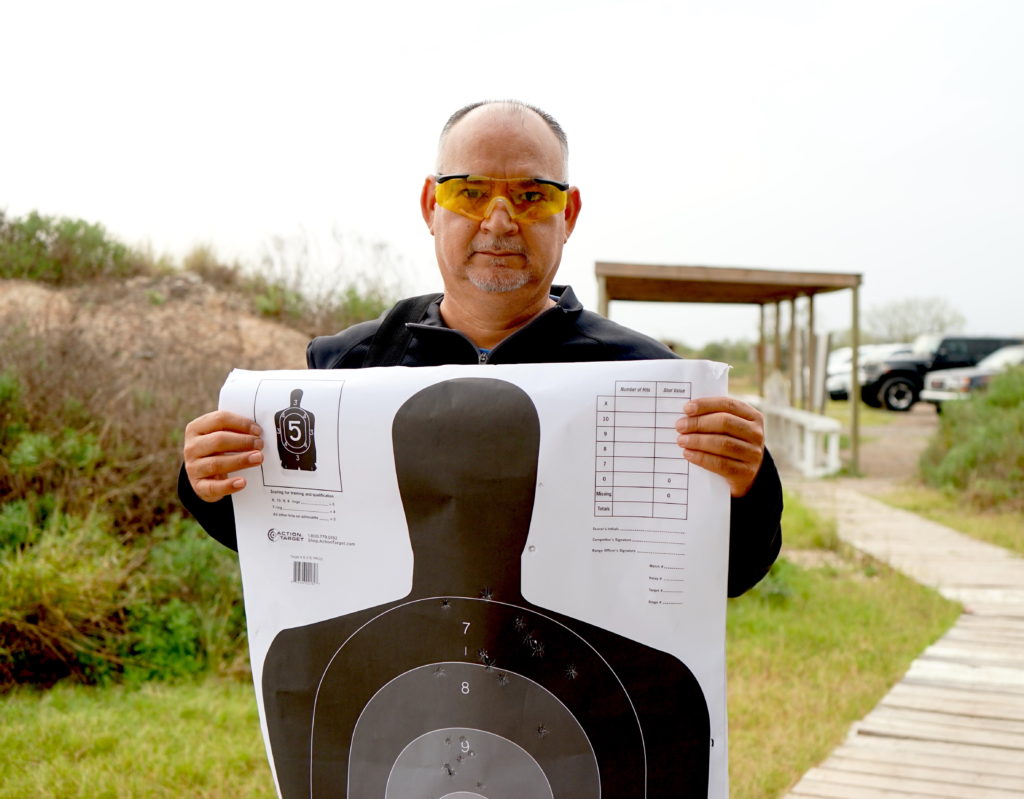
Rogelio Errisuriz a teacher at Brownsville Independent School District at a gun range in Los Fresnos, Texas. Photo credit: Sabrina Toppa.
Initially, Figueroa was critical of the NRA’s failure to approach Latinos. “I was telling them how they were messing up—they were missing an opportunity,” he told Fi2W. “You’re recruiting a bunch of Billy Bobs, and you should be recruiting Hispanics. They’re right there, they’re a bigger market,” he remembers telling them. Today, with Latinos constituting 40.2% of Texas’ population—compared to 39.8% of white Texans—he sees a demographic advantage that can’t be ignored. “The NRA is pushing to be an educator in the Hispanic communities about the Second Amendment,” Figueroa said.
Although the anti-immigrant rhetoric of the NRA alienates some Latino gun owners, Figueroa credits the NRA with some of the recent growth in Latino gun ownership. His claim is hard to verify, since the NRA does not collect information on the race or ethnicity of its members. People of color are 20% of new firearms license-holders in Texas, according to the most recent data from the Texas Department of Public Safety. The department tallies the state’s handgun licenses by race, not ethnicity, so while it accounts for white, Black, and Asian gun owners, it does not count the specific number of Latino gun owners.
“I Am Still Afraid of Guns”
Whether the LRA, NRA, or gun skeptics win the debate in rhetoric, the fact remains that Texan gun owners are more diverse than ever. On a Saturday at Vinson’s Firing Range in the border city of Los Fresnos, 53-year-old Leticia Errisuriz held a gun for the first time. “At the beginning, I was scared; my hands were sweating, I was kind of nervous,” she said after she sprayed rounds into a paper cut-out of a man.
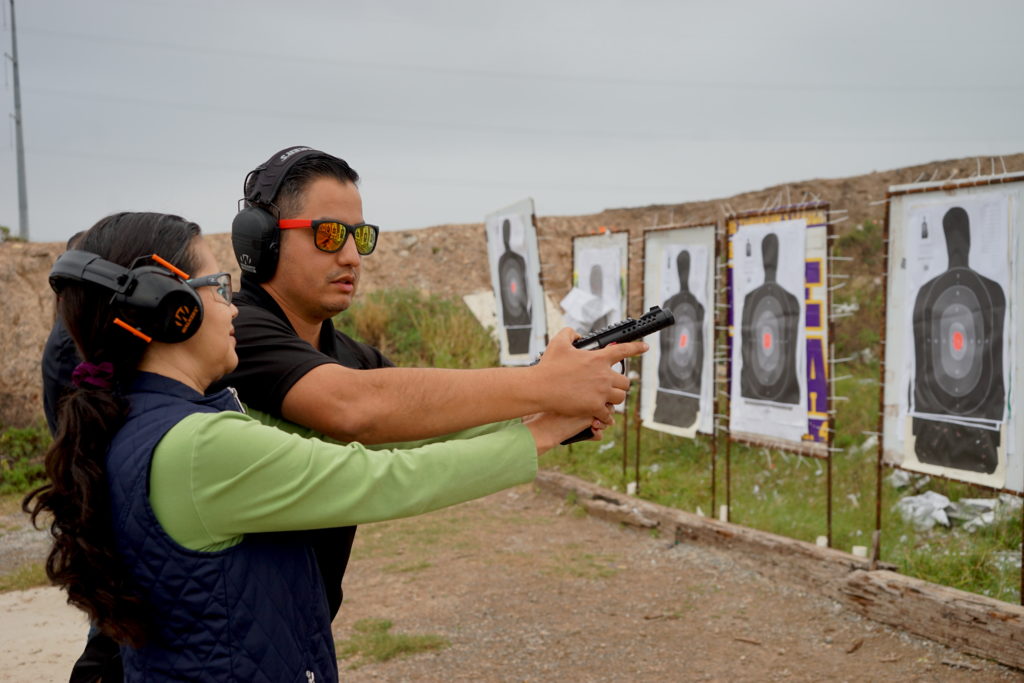
Julian Longoria a law enforcement officer training Brownsville Independent School District Teacher Leticia Errisuriz how to hold a gun. Photo credit: Sabrina Toppa.
She was at the range for a free gun safety class led by law enforcement officer Julian Longoria, who walked up to each shooter and helped them steady their guns. “The first thing I want you to [have] is good grip, high and tight,” he said, rearranging one of his student’s fingers on the firearm. “This is going to be like filling in a puzzle piece…. You want it to be level,” he said, training them to meet the sightline of the target.
Longoria half-jokingly recommended the group call itself Los Pistoleros, or the Gunslingers. The air was pierced by staccato gun pops, occasionally punctuated by peals of nervous laughter. After each set of rounds, Longoria asked his students to load the next magazine cartridge to help build their comfort with guns. Errisuriz and her husband, who are both teachers in Brownsville, were motivated to attend to better protect children in their school district. “I am still afraid of guns,” Errisuriz said. “I took the class just to be aware of how to handle a gun,” she added. “You never know nowadays.”
Errisuriz was one of a handful of Latino teachers from the Brownsville school district gathered for lessons at the range that Saturday. At the end of the session, the teachers were beaming. “I felt a bit nervous, a little bit tense, because I was never exposed to a gun,” said teacher Nemezia Saldaña, who wore protective gear to shield her eyes. Saldaña’s formative experiences with guns were shaped by her upbringing in Mexico’s northeastern state of Tamaulipas, where internecine gang conflict made her link guns with drug cartels. “Whenever I see guns, it keeps [them] on my mind,” she explained.
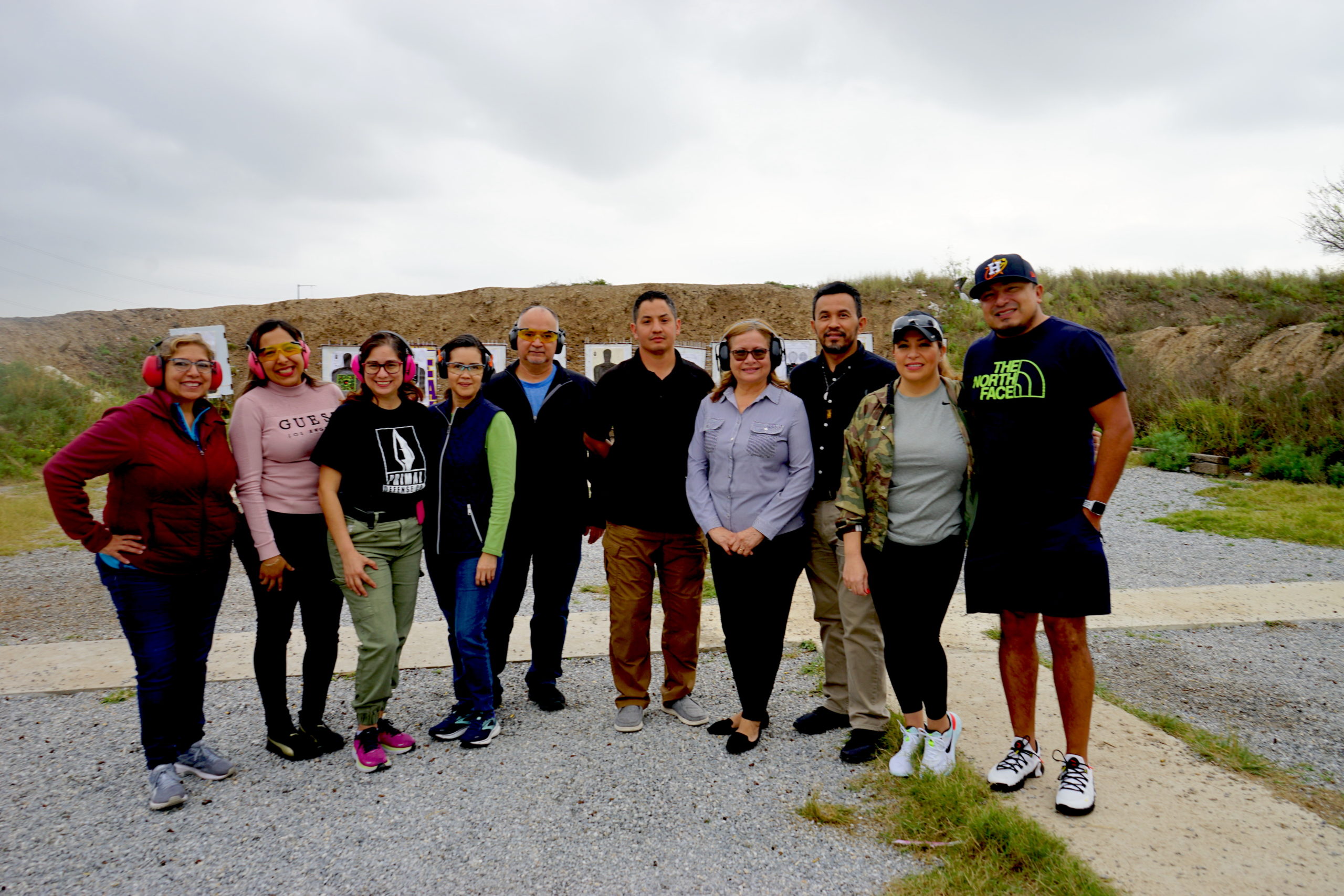
Latino teachers from Brownsville Independent School District train on gun safety in Los Fresnos, Texas. Photo credit: Sabrina Toppa.
Before she came to the shooting range, some in her community joked she would transform into yet another gun-toting citizen: “Mija,” they said, “now everybody is going to have a gun.” In Mexico, Saldaña said, many of her family members are still afraid of guns. “They think: ‘Oh, you have guns; guns kill,’” she said. But Saldaña was not dissuaded. “I want to protect students, myself, and my family.”
When asked if shooting a gun made her feel more Texan, Errisuriz responded, “No, not necessarily. I was a Texan before shooting a gun.”
Translated to Spanish by Virginia Lora and Maritza L. Félix.
Immigrants in a Divided Country is a multimedia online magazine series by Feet in 2 Worlds that explores the current political landscape from the perspective of immigrants. You can find links to additional stories in the series here.
Feet in 2 Worlds is supported by the John D. and Catherine T. MacArthur Foundation, The Ford Foundation, the David and Katherine Moore Family Foundation, the Ralph E. Ogden Foundation, the Fernandez Pave the Way Foundation, an anonymous donor and readers like you.


